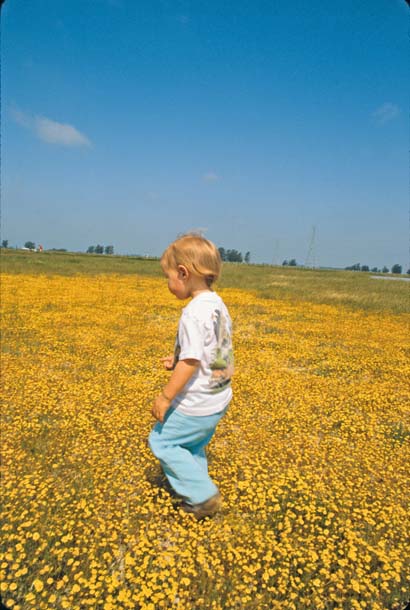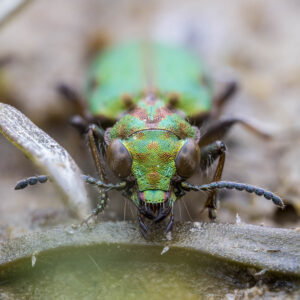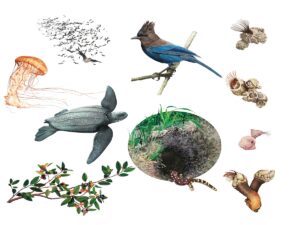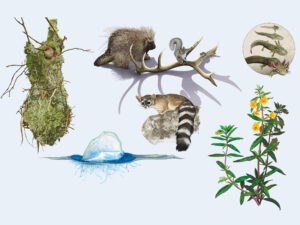Bob Holland looks more like an early California miner than a retired UC Davis professor whose primary passion is plants. On an overcast February morning, Holland is talking to a group of docents-in-training at the Jepson Prairie Preserve in eastern Solano County, where a nearby meadowlark competes with whining go-karts half a mile away.
Holland has dug a two-by-four-foot hole with straight sides to show the docents a profile of Jepson’s claypan soils. The top layer is friable (crumbly) and dark, but about a foot down the roots stop, the soil lightens in color, and water oozes out. He scoops a handful of mud from deep in the hole, forms it into a ball, and presses his thumb into it. “If your thumbprint shows, there is at least 24 percent of clay in the soil,” he says. “That’s the rule of thumb.”
Water is the first thing most people think of when they hear about vernal pools. That’s because we most often visit them in spring, and for good reason: Swaths of colorful wildflowers surround the pools and sweep across moist upland soils. But we should think just as much about earth: The flowers, bees, invertebrates, and amphibians that live here spend most of their lives in the soil, through summer drought and winter floods.
- Though a small section of the preserve is open to visitors any time, docents also lead hikers of all ages on guided walks through the preserve each spring. Photo by Treve Johnson Photography, treve.com.
Jepson Prairie is one of the few, and certainly one of the best, places in the Bay Area to see a functioning vernal pool ecosystem. Vernal pools are bodies of water that form when falling rain accumulates on relatively level ground but can’t percolate beyond an impermeable layer of hardpan soil. Vernal pools and native bunchgrass prairie habitats once dominated California’s Great Central Valley, but more than 80 percent of that acreage has been paved or plowed. Olcott Lake, the largest vernal pool at Jepson (about 88 acres when full), has been collecting water in relatively the same spot since the last ice age.
People have been here almost as long. Before the arrival of Europeans, the Patwin Indians hunted for deer and elk, fished in nearby waterways for sturgeon and salmon, and gathered grass seeds and other plants. After the Gold Rush, train tracks crossed California like crackles in a shattered pane of glass and passenger railcars stopped at a station at the prairie’s northern edge. Developers planned a city and planted 635,000 eucalyptus trees, but the parcels proved unattractive and most of the trees died in the shallow soils, leaving the vernal pool habitat here relatively undisturbed.
In 1892, botanist Willis Linn Jepson described the vernal pool flora here for the first time. But it took decades for this special place to get protected. With the discovery of Solano grass in the dry bed of Olcott Lake in 1959, as well as the recognition of the habitat’s importance for the rare Delta green ground beetle, interest in preserving the area grew. The Nature Conservancy purchased 1,566 acres of prairie and pools, and in 1982 the Willis Linn Jepson Prairie Preserve was dedicated. The following year it was brought into the University of California Natural Reserve System. It was later named a National Natural Landmark. In 1997, the Nature Conservancy transferred title to the current owner, Solano Land Trust.
While scientists might come for the rare grasses and beetles, it is the transcendent sight of sheets of wildflowers blooming on this open prairie that draws most visitors to Jepson. Every spring, docents lead tours of the prairie on weekends through Mother’s Day. “Every week is different,” says docent Jane Hicks. “In early spring, when the pools are filled with all kinds of critters, the adobe lilies emerge. The shocking-yellow goldfield rings that come in mid-spring are followed in April by yellow mariposa lilies.” Carol Witham, a vernal pool expert with the California Native Plant Society, explains that the flowers have adapted to the landscape and each can tolerate having its feet wet for different periods of time. As the water evaporates, the goldfields, tidy tips, and sky-blue Downingia emerge in waves.
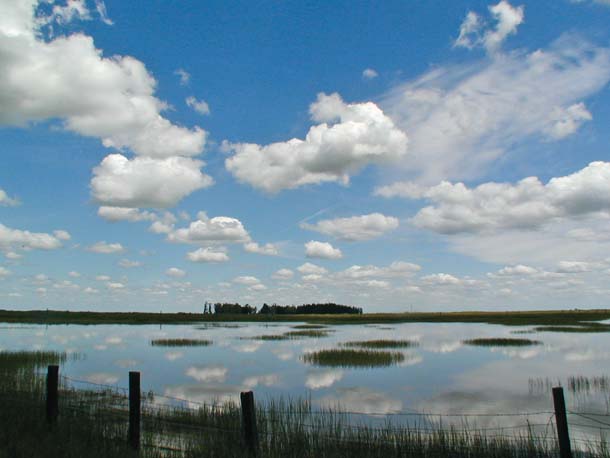
- Olcott Lake, shown here in April, is the preserve’s largest pool at about 88 acres. Photo by Debbi Brusco, moonlittrails.com.
But water is only half the story for those spring flowers. For at least five months of the year, the upland soils are parched, the beds of the dry pools are cracked, and the tawny, windblown grasses drape across the hiccupping topography of small hummocks called mima mounds. The mounds are only a few feet high, and their origin remains something of a mystery. Holland says there are over 50 theories on the topic, including burrowing pocket gophers, shifting soils during the last ice age, and seismic activity. He offers a simple experiment to explain the seismology theory: Evenly sift flour (standing in for loose soil) onto a baking sheet (the claypan layer), shake the pan repeatedly (countless earthquakes over millennia), and the flour will form into small hills.
When the year’s first rains hit the parched soil, the creatures of the prairie begin to come to life. One of the most charismatic creatures of a vernal pool ecosystem is the California tiger salamander. When we retreat indoors during early winter rains, mature California tiger salamanders emerge from their burrows to migrate to the filling pools for breeding.
For the past five years, the majority of those making their rainy-night migrations here at Jepson have run into a six-inch-high black mesh fence that leads to temporary holding buckets. The fence and the buckets are the tools of a habitat study conducted by graduate student Christopher Searcy and the UC Davis Shaffer Lab. For over five years, the scientists have recorded more than 15,000 salamander captures, the largest data set yet collected on the terrestrial habitat of the California tiger salamander, which is protected by the federal Endangered Species Act. The findings indicate that to protect 95 percent of a population, a “terrestrial buffer” should stretch more than 6,000 feet around the pool, covering an area of 2,800 acres. “They move a lot in the landscape,” Searcy says, and it’s important to have connectivity between ponds so the salamanders can repopulate other ponds. “Jepson Prairie offers the best hope for this scenario because several properties with breeding ponds are connected and protected.”

- Endangered California tiger salamanders breed in the pools each winter and then take refuge in ground squirrel burrows in the heat of summer. Photo by Sebastian Kennerknecht, pumapix.com.
On a drizzly December morning, I meet Searcy and a team of volunteers before dawn. In our mud boots, Searcy and I start for a 1,300-foot-long drift fence installed near the shoreline of Olcott Lake. He lifts the propped-open lids of each plastic bucket embedded in the soil every 30 feet. When the migrating salamanders, which travel in the dark of night, run into the fence, they travel alongside it until falling safely into a bucket. When we find a salamander, Searcy measures it, takes its picture, and gently turns it over to determine sex and maturity. After examining it for about three minutes, Searcy carefully places the docile amphibian in a gopher burrow on the other side of the fence. A young man of few words, Searcy grew up handling salamanders with his grandfather, Nelson Hairston, an ecologist and professor at the University of North Carolina (a much wetter spot, with the world’s highest diversity of salamanders). The California tiger salamander is the only salamander that lives in California’s drier valley climate. “It’s amazing these salamanders survive here at all,” Searcy says. The larvae need at least 100 days to mature, and if the pools dry before they have fully matured they will die–even if there are early substantial rains. No matter how early breeding starts, the pools need to hold water until mid-May when metamorphosis begins. Based on captures, Searcy estimates that there are around 19,000 larvae in Olcott Lake. Unless March and April are unusually dry, as they were three years ago, this could be a prolific year for the salamanders at Jepson Prairie.
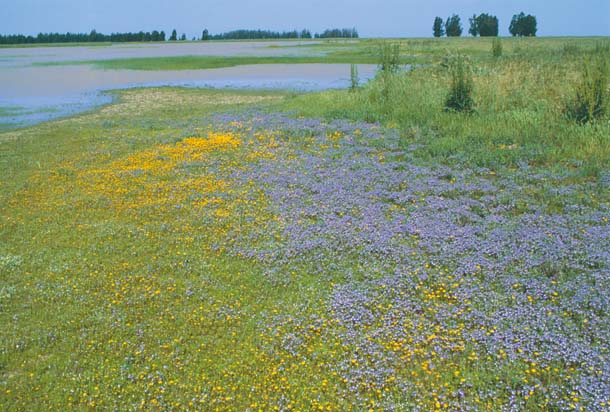
- Different species of wildflowers (here goldfields and downingia) bloom along the edges of vernal pools as they dry up through late spring and summer. Photo by Treve Johnson Photography, treve.com.
On another winter day, as two magpies stand guard at the entrance to the preserve, the landscape glistens with shallow pools and snow geese dot the distant edge of Olcott Lake. Though beautiful, it is not pristine: Power lines divide the views, and giant wind turbines seem to march across the southern horizon.
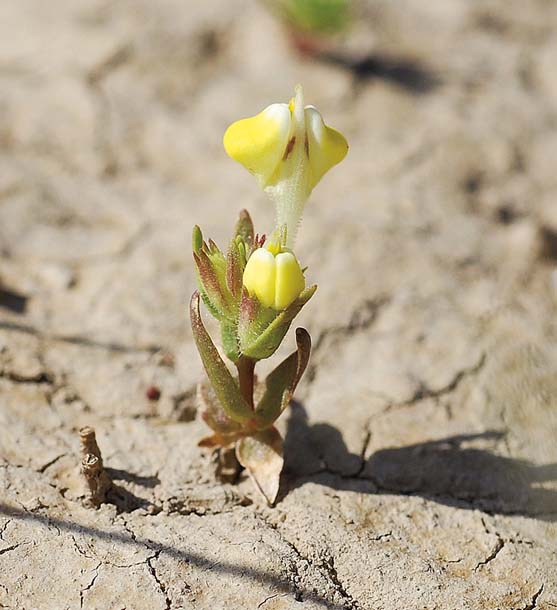
- Federally threatened fleshy owl’s-clover growing in the dried-out bottom of Olcott Lake. Photo by Doug Wirtz.
C.J. Addington, a docent since 1996, shares his enthusiasm for invertebrates with the docents-in-training. “At first glance, the pool looks like a puddle of muddy water, but look closer and it’s teeming with life,” he says. “There are thousands of creatures swimming around, creatures that have been hatching here since the end of the last ice age.” These invertebrates evolved long before fish and can only live in ephemeral waters where fish, their predators, can’t survive.
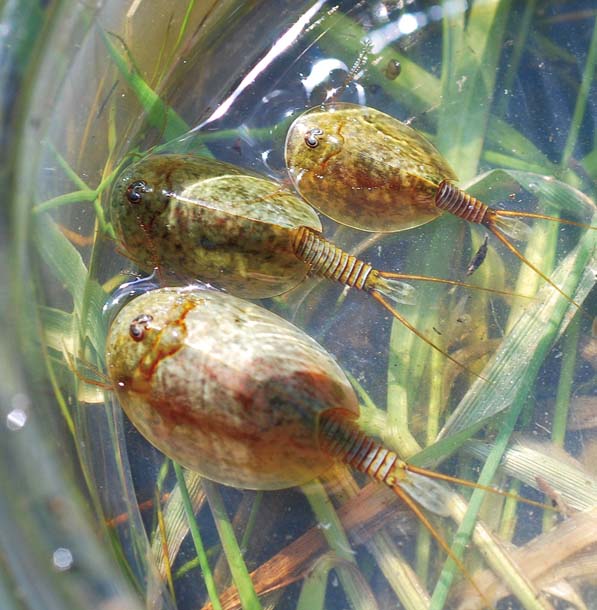
- Federally endangered vernal pool tadpole shrimp reproduce each season, leaving a new generation to wait out the dry season as cysts that hatch during a subsequent winter. Photo by Doug Wirtz.
Addington, a certified dipper with California Fish and Game (even wading in this lake requires a permit), enters the pool to collect water. He pours it into clear plastic containers for the docents to look at under magnification. The first creature he points to is the conservancy fairy shrimp, a federally endangered species named after the Nature Conservancy. It’s one of the first invertebrates to show up in the pool, he says, and as far as fairy shrimp go, it is large and active. These shrimp eat and breed constantly during their brief lives, and the females lay up to 50 eggs a day. The males have special grabbers at the end of their antennae used to capture females. They also have two penises, a fact that always gets the attention of Addington’s science students from Roseville High School. “Most kids suffer from nature deficit disorder, and this is a great place to bring them,” says Addington. “When they first get here they think it’s boring, but by the end of the day they want to come back.”
As the riotous orgy in the pool continues even while the water evaporates, the flowers and native bees appear. “The showy displays of the flowers draw the crowds, but it’s really for the bees that they put their colors forth,” says entomologist and UC Davis professor emeritus Robbin Thorp. There are 40 to 50 species of native bees at Jepson Prairie, several of which are specialists that pollinate only one species of flower. For example, just one kind of bee pollinates the sky-blue Downingia, a low-growing late bloomer. As the bee gathers pollen to feed its offspring, it tickles the hairs on the column that holds the anthers and stigma, and pollen is forced out of the tube. The bee gets doused with pollen, then goes to another plant and uses its body like a paintbrush, pollinating the flower as it gathers more pollen for itself.
Vernal pool flowers and bees have also adapted to prolonged periods of inundation and drought, and the timing of their emergence is synchronized. For example, during the drought of 1975-76, meadowfoam flowers didn’t bloom, and the bees didn’t come out at all. But when the flowers bloomed the following year, the bees came out to meet them.
As of early March, the prairie had received average rainfall of 17 inches. “The pattern of rain affects the flowers and aquatic life,” says Kate Mawdsley, a longtime Jepson docent. “We’ll just have to wait and see what nature gives us.” It’s not just a matter of how much rain falls and when, but of temperature as well. Cold winters tend to suppress grasses, which promotes flower growth. If it gets warm fast, that will also trigger the season. “I predict a great flower year,” says Witham. The best time for vernal pool flower shows changes from year to year. The good news is that as the water evaporates and one flower species fades, another blooms.
By mid-June, if all goes well, the young California tiger salamanders will have exited the pool and found burrows, the bees will have finished their underground nests, and the claypan soils in the pool will cradle the shriveled, inert eggs of the invertebrates until rain again breathes life into the earth of Jepson Prairie.

- Map by Ben Pease, peasepress.com.

Getting There
From I-80 eastbound, take Highway 113 south at Dixon. Travel 10 miles due south. When Highway 113 takes a 90-degree turn to the east, continue straight onto Cook Lane. Proceed over the creek and the railroad tracks until you see the eucalyptus grove and interpretive sign. Beginning in March, docents lead two-hour tours at 10 a.m. on Saturday and Sunday through Mother’s Day. No reservations are required, but large groups should call in advance. Donations are requested but not required. Visitors can walk the docent triangle anytime, seven days a week, but access beyond the fenced areas is limited to the tours.

.jpg)
